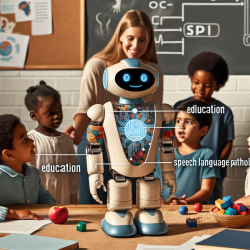In the realm of speech-language pathology, leveraging technology to improve educational outcomes is becoming increasingly common. One emerging field is the use of socially assistive robotics (SAR) in education. A recent study, "Ethical Considerations from Child-Robot Interactions in Under-Resourced Communities," provides valuable insights into the ethical and pedagogical challenges of deploying SAR in educational settings, particularly in under-resourced communities. This blog aims to highlight key findings from the study and offer practical recommendations for practitioners.
Key Ethical Considerations
The study identified four primary ethical considerations that should be taken into account when deploying social robotics technologies in educational settings:
- Language and Accent as Barriers in Pedagogy: The study found that robots programmed with Westernized English accents posed a significant barrier for students in under-resourced communities. This accent gap can confuse students and disrupt the learning process.
- Effect of Malfunctioning and (Un)Intended Harms: Technical malfunctions can lead to unintended psychological impacts on students, including loss of trust and interest. The study emphasizes the need for reliable technology and proper troubleshooting protocols.
- Trust and Deception: The use of Wizard-of-Oz (WoZ) methodology, where a human controls the robot, can lead to ethical dilemmas. Students may feel deceived if they discover the robot is not autonomous, affecting their trust in the technology.
- Ecological Viability of Innovation: The study highlights the need for context-specific designs that consider the socio-economic and cultural realities of under-resourced communities. This ensures that the technology is both accessible and effective.
Practical Recommendations for Practitioners
Based on the study's findings, practitioners can implement the following strategies to improve the deployment of SAR in under-resourced educational settings:
- Localized Programming: Ensure that robots are programmed with accents and language patterns that are familiar to the students. This can help bridge the accent gap and improve comprehension.
- Robust Technical Support: Establish a robust technical support system to quickly address malfunctions. This includes having backup plans and troubleshooting protocols in place.
- Transparency in Research Methods: Be transparent with students about the capabilities and limitations of the robot. Avoid using deceptive practices that could undermine trust.
- Contextual Design: Engage with local communities to understand their specific needs and challenges. Design robots that are culturally and contextually appropriate.
Encouraging Further Research
The study underscores the need for more research in this area, particularly in under-resourced settings. Practitioners are encouraged to collaborate with researchers to develop a deeper understanding of the ethical and pedagogical implications of SAR. Such collaborations can lead to the creation of more effective and ethically sound educational technologies.
To read the original research paper, please follow this link: Ethical Considerations from Child-Robot Interactions in Under-Resourced Communities










